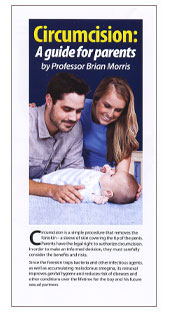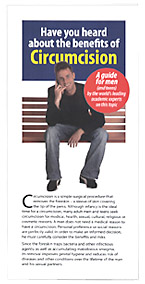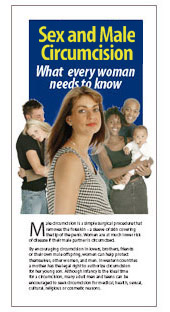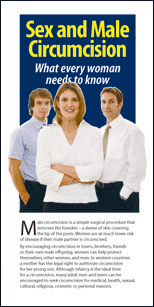Why Medical Bodies and Others Should Not Advise That Circumcision Should be Delayed Until the Boy Can Make the Decision for Himself
Summary:
WHY CIRCUMCISION SHOULD NOT BE DELAYED
• Protection against UTIs and kidney damage in infancy is lost.
• Freedom from phimosis and balanitis in childhood and at puberty is lost.
• Circumcision after boys become sexually active means loss of more benefits associated with STI prevention.
• The risk of complications is higher for later circumcisions.
• The cost (to the individual or the public purse) is much higher.
• Educational resources for boys to make an informed decision are lacking
• Large-scale adolescent circumcision would strain medical resources.
• Boys who choose circumcision will certainly wish it had been done in infancy.
• Many boys will not want to face an operation even though they wish to be circumcised.
• Major international and American health and medical organizations are now urging circumcision, especially in infancy.
Reasons in more detail:
1. No information campaign. How can an adolescent male be “informed”, when there is no major campaign to provide information about the enormous benefits of male circumcision to anyone, let alone to adolescent males? Do medical bodies and others intend to conduct a campaign so that adolescent males become informed about the benefits of circumcision? We see such a campaign as being important, since it will alert older uncircumcised males, and their partners, of the benefits of male circumcision. But it is also important to ensure a high level of male circumcision by promotion of circumcision in infancy, when it is much simpler and cheaper to perform, and can be pain-free.
2. High risk behaviour the norm. Consideration should be given to data already available on the ability of adolescent males to make informed choices for their own well-being in other areas such as healthier eating, not smoking, moderation of alcohol intake, especially avoiding binge drinking, avoidance of illegal drugs, safer driving, safer sex, responsible, mature social behaviour, etc.
3. Hard to find a doctor to perform circumcision. Even if an occasional adolescent male, decides he would like to be circumcised, how would most males of this age find a doctor willing to perform the circumcision, especially in an environment where adults (such as parents of baby boys) find it difficult?
4. Stress imposed. Consideration should be given to the psychological stress and worry (even if unwarranted) for the boy while he waits to undergo his circumcision.
5. Later circumcision more complex and risky. Consideration should also be given to the fact that the operation is much more involved and thus longer, often requires a general anaesthetic, which poses inherent risks, and the risk of complications (generally seen in up to 5% of operations) is approximately 10 times higher for circumcision in older boys and adults as compared to infants. In addition, healing is slower, stitches or tissue adhesives are needed, and a more visible scar may result.
6. Won’t be able to afford it. How will an adolescent male be able to afford it? (where costs are often over $1,000 for an adolescent circumcision, compared with less than $300 for an infant circumcision)? What is the likelihood of the Government providing the funding needed? …. or increasing the rebate substantially?
7. Not enough doctors. Will there be sufficient doctors skilled in the circumcision of adolescent and older males to meet demand? Do medical bodies plan to conduct education programmes to ensure an abundant supply of such doctors? And given the fact that many doctors and other health professionals are overworked as it is, when will they find the time to carry out these circumcisions, noting that a longer operating time is required compared to circumcision carried out in infancy?
8. Inconvenient. How will the adolescent males be able to organize to take time off school or work to enable the procedure to be carried out? Especially given the numerous other activities that adolescent males engage in.
9. Peer pressure problems. And how will he explain his decision to his peers that he will not be available for a couple of weeks because he is going to be circumcised? And what about the peer pressure, teasing and bullying – by uninformed, ignorant, immature friends – to stop the boy having it done?
10. Parental problems. If he is required to get parental consent, then what adolescent male is going to be able to ask for his parents’ approval or consent? What if the parents resist, especially knowing that they might have made a poor choice for their son when he was born?
11. Anger that he wasn’t done in infancy. Medical bodies may need to consider the anger that an adolescent male will most likely feel that he wasn't circumcised as a baby when this minor procedure, if done in infancy, would have been over and done with and forgotten.
12. Missed opportunity to avoid common health problems early in life. More importantly, infant circumcision would have protected him from various paediatric problems requiring medical attention, such as:
(i) urinary tract infections are common in infants. The rate of UTIs is higher in infancy than any other year of life. UTIs often cause damage to the still developing paediatric kidney. This is well known from large observational studies and a RCT. UTIs are at least 10-times more common in uncircumcised than in circumcised infant boys (and higher than in infant girls). It is important to also note that UTIs continue over the lifetime – cumulative prevalence is 1 in 3 for uncircumcised males, compared with less than 1 in 20 for circumcised males).
(ii) years of phimosis (seen in 10–50% of boys).
(iii) balanitis and balanoposthitis.
13. Less protection from penile cancer. It should also be realized that later circumcision means lesser protection than in infancy against penile cancer that affects approximately 1 in 600 uncircumcised men, but virtually no circumcised men. (With the ever-increasing proportion of elderly in the population, the cost of geriatric care for men who are uncircumcised will continue to rise, a fact not considered by most parents when their baby boy is born.)
14. Boys often start having sex early, so risk STI. Some boys become sexually active during early adolescence, so the benefits can be largely lost if the procedure is delayed. Moreover, the protective effect may be higher if the circumcision was done in infancy. Certainly, the risk of HIV is higher during the period of healing after a circumcision if the boy ignores advice and engages in sexual activity.
15. RACP doesn’t advise vaccination be delayed – what’s the difference? Would medical bodies also consider that vaccinations should be delayed until later so that the adolescent male can make up his own mind? The issues are similar, although the adverse medical consequences of vaccination are potentially more serious than infant male circumcision, despite the overall benefits to the population and most individuals. Male circumcision is often referred to these days as a “surgical vaccination”.
16. A “circumcision bus” doing the rounds of schools? One might consider the recent campaign to get 12 year-old girls vaccinated against two high-risk (oncogenic) types of HPV. This has been reasonably effective because it was by school visitation and strong encouragement, with parental consent. So do medical bodies plan to insist on something similar for male circumcision in high schools? Would there be, for example, a “circumcision bus” doing the rounds of high schools to encourage adolescent males to become circumcised? (With similar media promotion by governments and others.)
17. Not part of our culture. Although there are some countries and cultures, such as Black Africans, as well as indigenous Australians and Pacific Islanders, where circumcision tends to be performed as part of coming of age ceremonies, there would need to be a paradigm shift in the culture of the majority of the population in most other countries for circumcision at, say, around puberty, to become the norm. The long-standing tradition in most populations of Anglo-Celtic heritage, such as in the USA, Australia and New Zealand, has been for circumcision in infancy. This remains the best time for the many reasons listed, so it would be much easier to promote what is already popular amongst informed parents, rather than try to introduce a new concept.
18. In advanced medical systems such as that of the USA circumcision is almost routine in infancy for majority groups. When considering what is best for boys, medical bodies outside of the USA might look to the USA and note the near universal infant circumcision rate amongst Anglophile American males. This well-educated population, having the highest quality medical technology and expertise in the world, has chosen to continue circumcising its baby boys.
19. Circumcision in infancy now encouraged by the CDC, AAP, AUS, WHO, UNAIDS, NIH, and a pediatric journal. The Centers for Disease Control and Prevention (CDC) and the American Academy of Pediatrics (AAP) have made statements recently indicating that their new policy will be to strongly encourage infant male circumcision in the USA. The American Urological Association (AUS) already has a positive circumcision policy. WHO, UNAIDS and other bodies have released statements favouring male circumcision in high-risk settings and have pointed out that infancy represents the optimum time for this to be done, notwithstanding the urgent need to circumcise men and adolescent boys. In 2010 a review by experts at John’s Hopkins University and the National Institutes of Health highlighted the long-standing benefits from infancy onwards, and provided an update on newer randomized controlled trial data concerning STIs [Tobian et al., 2010]. The article argued the case for neonatal circumcision and concluded that “with mounting evidence that male circumcision decreases viral STIs, genital ulcer disease, and penile inflammatory disorders in men, and bacterial vaginosis, T. vaginalis infection, and genital ulcer disease in their female partners, it is time for the AAP policy to fully reflect these current data”. This was supported by an editorial commentary in the same issue [Brady, 2010]. The journal also published a new brochure intended for the parents of baby boys, listing the health benefits and which stated that risks of the procedure in infancy were very small [Moreno et al., 2010].
Conclusion:
Thus, taken together, the argument that circumcision be delayed does not stack up, and can be regarded as muddled thinking at best or a manifestation of the propaganda of the anti-circumcision movement that knows well that if they can win the argument that circumcision be delayed until the adolescent or adult male can make up his own mind then it is never likely to happen at all, except in a few rare instances.
For more information see article “A ‘snip’ in time: what is the best age to circumcise” [Morris et al., 2012b].



